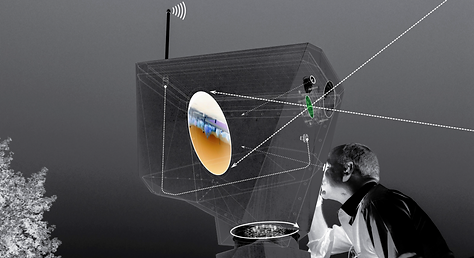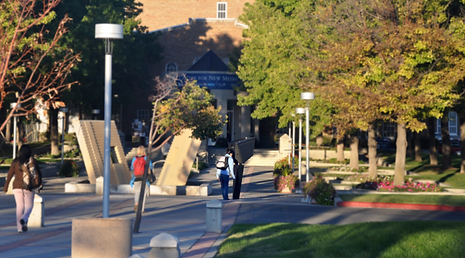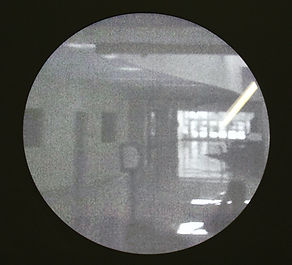





Light Camera Action
A permanent public art commission from the Utah Arts Council and Public Art Program
For the Salt Lake Community College Center for New Media at the South City Campus in Salt Lake City, Utah (2013)
Project Conception/Producer: Stephan Koplowitz
Camera Designs/Producer: KBAS (Keith Kaseman and Julie Beckman)
Digital Design: Stephan Koplowitz
Lens Fabrication: George Keene
Camera Fabricators: Maloya Laser, Kin & Co and Plasitk Banana Design Workshop
Camera Electronics and Digital Dispaly: Perfection Electricks (Marty Chafkin)
Camera Installation: Biesinger Construction
Structural Engineer: Robert Silman Associates
special thanks: Jim Glenn, Utah Division of Arts and Museums
Light Camera Action consists of three camera obscuras tethered by digital video broadcasting live to one location as three images. Streaming images flip orientation at a frequency determined by the amount of daylight hours of each passing day; the faster the frequency, the shorter the day. Combining ancient and modern technologies, these instruments serve as an invitation to experience and engage with the known environment in new and imaginative ways.
LIGHT CAMERA ACTION, created in partnership between Stephan Koplowitz and KBAS is a permanent public art installation of three camera obscuras designed by KBAS and commissioned by the Utah Arts Council for the Salt Lake City Community College New Media Center. Raw projections from the three camera obscuras are captured by high-definition video located inside each camera structure and woven through a dynamic video installation in the heart of the New Media Center.
Upon entering Camera A (pictured below, Core-Ten steel, raw and galvanized), a tiny building permanently perched on the front lawn of the original school building, one can adjust the focus of the stationary lens by moving the projection screen forward and back with the provided crank-handle.
All photo and renderings by KBAS - additional photos by Stephan Koplowitz




Camera B (pictured below, plywood and steel), precisely landed in a newly active and charged corridor within the New Media Center, capturing the social interaction of its students and the hustle and bustle of this creative atmosphere.




Camera C (pictured below, powder-coated galvanized steel), swivels 360 degrees on its base-post inviting interaction through its viewing oculi.




Electronics and Digital Display (pictured below) Each camera contains an IP (Internet Protocol) video camera which captures the projected image. The video is transmitted to one of three computers located inside the building near Camera B and displayed on one of three 50” monitors. Each Camera Obscura will display an upside down image on its internal screen. The video cameras will capture that image and transmit it to the computers, where it will be programmatically manipulated and displayed on the 50” displays. At intervals, the images displayed on the monitors will be either flipped or rotated, depending on the parity (odd or even) of the day.






A short history of camera obscuras:
In the mid sixteenth century Giovanni Battista della Porta is reported to have made a huge "camera" in which he seated his guests, having arranged for a group of actors to perform outside so that the visitors could observe the images on the wall. The story goes, however, that the sight of upside down performing images was too much for the visitors; they panicked and fled, and Battista was later brought to court on a charge of sorcery.
The Camera Obscura (Latin for "dark room") is a dark box or room with a hole in one end. If the hole is small enough, an inverted image can be seen on the opposite wall. Glass lenses were fitted into the holes late in the sixteenth century. The image that appears shows the colors, distance and motion of what is happening outside the camera: people moving, trees bending in the wind, cars driving by, clouds floating overhead.
The first cameras were enormous. Some had an outer shell with lenses in the center of each wall, and an inner shell containing transparent paper for drawing; the artist needed to enter by a trap door. Other versions also appeared. Tent-type cameras were also in use - even up to the beginning of the nineteen hundreds. Visual artists have used camera obscuras as drawing aids since the sixteenth century, focusing an image on a piece of paper and using it to recreate the natural shapes and colors. Camera Obscuras were the world's first technology for perceiving space, for visualizing with other than the naked eye.
It has lately been in the news with a controversial debate over whether Dutch master painters used this technology to paint with perspectives and detail not seen prior to that time period. The artist David Hockney has been giving lectures in support of the theory that
Vermeer et al used this technology to enhance their painting. From that historical period up until the invention of photography, Camera Obscuras have been a part of the history of imaging and perception.